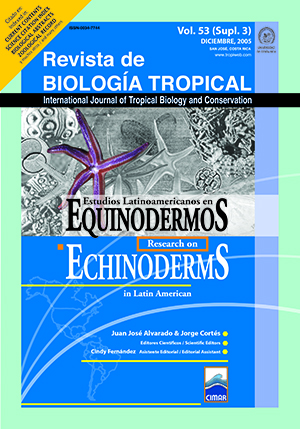Abstract
Population state of Echinometra lucunter (Echinoida: Echinometridae) and its accompanying fauna on Caribbean rocky littoral from Colombia. In order to know the current condition of the Echinometra lucunter population in the Colombian Caribbean, ten zones of the most representative rocky-shore were selected for sampling between November 2002 and May 2003. In each zone, four transects of 10.25 m2 were located parallel to the coast, and measured with a 0.25 m2 quadrant under the tide level. Two subsamples of 0.01 m2 were chosen from each quadrant, in order to determine the sea urchin heights and its associated fauna. This species was found in nine of the selected zones where the rocky-shore was of sedimentary origin and was absent in Punta Gloria because of the igneous origin of the rock, that the sea urchins cannot bore. The greatest average densities were obtained in Zapsurro and Inca Inca with 69 and 65 ind/m2 respectively; these are high values for the Caribbean Sea, whereas Acandí and Punta Betín had the lowest because of continental water discharges. The most frequent test diameter was between 25 and 40 mm (smaller on the western zones). The density of E. lucunter and of its associated fauna (including the endemic Ophiothrix synoecina) in the Santa Marta area decreased in the last decade. Rev. Biol. Trop. 53(Suppl. 3): 291-297. Epub 2006 Jan 30.References
Abbott, D. 1974. Introduction and review. Chapter 1, p.1-7. In D. Abbott, J. Ogden & I. Abbott (eds.). Studies on the activity pattern, behavior, and food of the echinoid Echinometra lucunter (Linnaeus) on beachrock and algal reefs at St. Croix, U.S. Virgin Islands.
Acero, A. & J. Garzón. 1987. Los peces marinos hallados durante la expedición Urabá II al Caribe chocoano (Colombia). An. Inst. Inv. Mar. Punta Betín 17: 113-136.
Acosta, A. 1993. Contamination gradient and its effect on the coral community structure in the Santa Marta area, colombian Caribbean, p. 233-239. In R. Ginsburg (ed.), Proceedings of the Colloquium on Global Aspects of Coral Reefs: health, hazards and history. Miami.
Allain, J. 1976. Erizos de la costa norte de Colombia. Inf. Museo Mar 15: 1-18.
Alvarez, L. 1978. Listado preliminar de los equinodermos de la costa Atlántica colombiana. Bol. Museo Mar 10: 24-39.
Bak, R. 1990. Patterns of echinoid bioerosion in two Pacific coral reef lagoons. Mar. Ecol. Prog. Ser. 66: 267-272.
Borrero-Pérez, G., O. D. Solano & M. Benavides. 2002a. Lista revisada de los erizos del Mar Caribe colombiano. Biota Col. 3: 137-144.
Borrero-Pérez, G., M. Benavides- Serrato & O. D. Solano. 2002b. Ophiothrix synoecina, p.154-155. In N. Ardila, G. Navas & J. Reyes. (eds.), Libro rojo de invertebrados marinos de Colombia. INVEMAR. Ministerio del Medio Ambiente. La serie de Libros Rojos de Especies Amenazadas de Colombia. Bogotá, Colombia.
Caycedo, I. 1979. Observaciones de los equinodermos en las Islas del Rosario. An. Inst. Inv. Mar. Punta Betín 11: 39-47.
Díaz, J. M. 1991. Ecosistemas litorales del Caribe colombiano. Documento de trabajo No. 4, p. 1-34. In CORPES (eds.). Perfil ambiental del Caribe colombiano. Santa Marta.
Gallo, N. 1988. Contribución al conocimiento de los equinodermos del Parque Nacional Natural Tayrona I. Echinoidea. Trianea 1: 99-110.
Hendler, G., J. Miller, D. Pawson & P. Kier. 1995. Sea Stars, Sea Urchins and Allies: Echinoderms of Florida and the Caribbean. Smithsonian Institution, Washington and London. 390 p.
Hoskin, C. & J. Reed. 1985. Carbonate sediment production by the rock-boring urchin Echinometra lucunter and associated endolithic infauna at Black Rock, Little Bahama Bank. The Ecology of Coral Reefs. Symp. Ser. Undersea Res. 3: 151-161.
Hunt, M. 1969. A preliminary investigation of the habits and habitat of the rock boring urchin, Echinometra lucunter, near Devonshire Bay, Bermuda, p 35- 40. In R. N. Ginsberg & P. Garrett (eds.). The 1968 Seminar on Organism- Sediment Relationships. Bermuda Biol. Sta., Spec. Publ. No. 2.
INVEMAR. 2001. Informe sobre el estado de los ambientes marinos y costeros en Colombia: 2000. Serie de documentos generales 3. Santa Marta. 138 p.
Kunz, N. & P. Collins. 1974. Population distribution and size class structure of Echinometra lucunter on beachrock at Boiler Bay, St. Croix, U.S. Virgin Islands. Chapter 4a, p. 21-26. In D. Abbott, J. Odgen, & I. Abbott (eds.). Studies on the Activity Pattern, Behavior, and Food of the Echinoid Echinometra lucunter (Linnaeus), on Beachrock and Algal Reefs at St. Croix, U.S Virgin Islands. West Indies Laboratory. Fairleight Dickinson University.
McPherson, B. 1969. Studies on the biology of the tropical sea urchins Echinometra lucunter and Echinometra viridis. Bull. Mar. Sci. Gulf. Carib. 19: 195- 213.
Ogden, J. 1977. Carbonate sediment production by parrot fish and sea urchin on Caribbean reefs, p. 281-288. In S. Frost, M. Weiss & J. Saunmders (eds.). Reefs and Related Carbonates-Ecology and Sedimentology. Stud. Geol. No. 4. Am. Assoc. Petrol. Geol. Tulsa, Oklahoma.
Schoppe, S. 1990. Die vergesellshaftung zwischen Acyrtus rubiginosus (Gobiesocidae), Clastotoechus vanderhorsti (Porcellanidae), Ophiothrix sp. (Ophiotrichidae) und ihrem gesteinsbohrenden wirt Echinometra lucunter (Echinometridae) im felslitoral von Santa Marta, Kolumbien. Msc. Thesis, Justus- Liebig University, Giesen, Alemania. 68 p.
Schoppe, S. 1991. Echinometra lucunter (Linnaeus) (Echinoidea, Echinometridae) als wirt einer komplexen lebensgemeinschaft im Karibischen Meer. Helgo. Meeres. 45: 373-379.
Schoppe, S. 1993. Die karpose um den felsbohrenden seeigel Echinometra lucunter (L.): Untersuchung der lebensraumbedingungen und der biologie der assoziierten Arten. Dissertation, Justus- Liebig University, Giensen, Alemania. 128 p.
Schoppe, S. & B. Werding. 1996. The boreholes of the sea urchin genus Echinometra (Echinodermata: Echinoidea: Echinometridae) as microhabitat in tropical South America. P.S.Z.N.I.: Mar. Ecol. 17: 181-186.
Sokal, R. & J. Rohlf. 1969. Biometría. Principios y métodos estadísticos en la investigación biológica. H. Blume, España. 832 p.
Werding, B. 1977. Los porcelánidos (Crustacea: Anomura: Porcellanidae) de la región de Santa Marta, Colombia. An. Inst. Inv. Mar. Punta Betín 9: 173- 214.
##plugins.facebook.comentarios##

This work is licensed under a Creative Commons Attribution 4.0 International License.
Copyright (c) 2005 Revista de Biología Tropical






